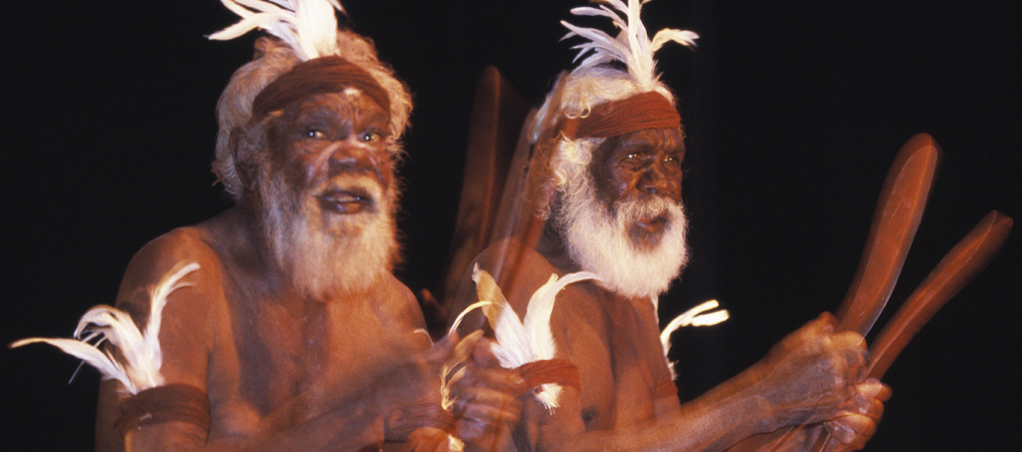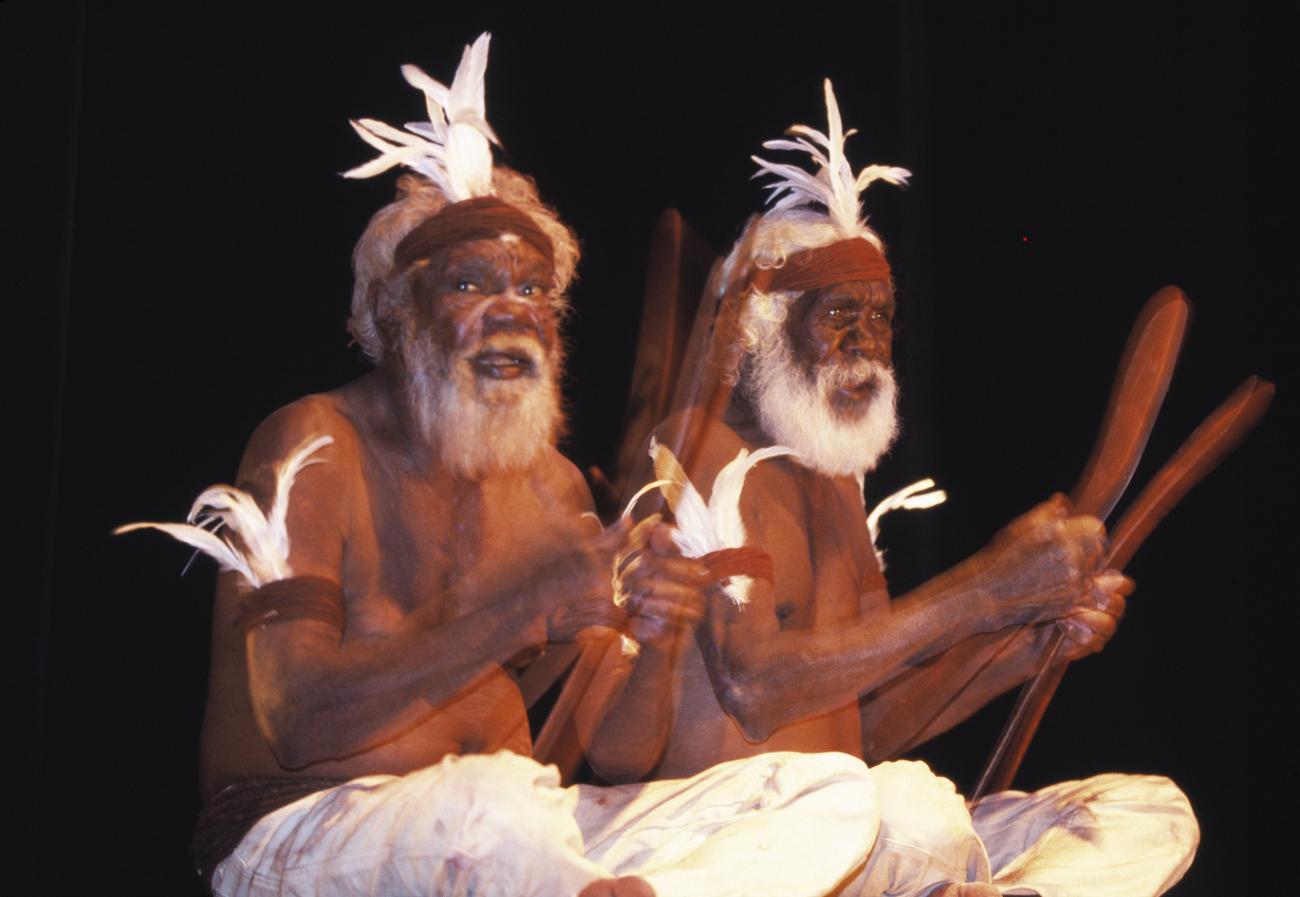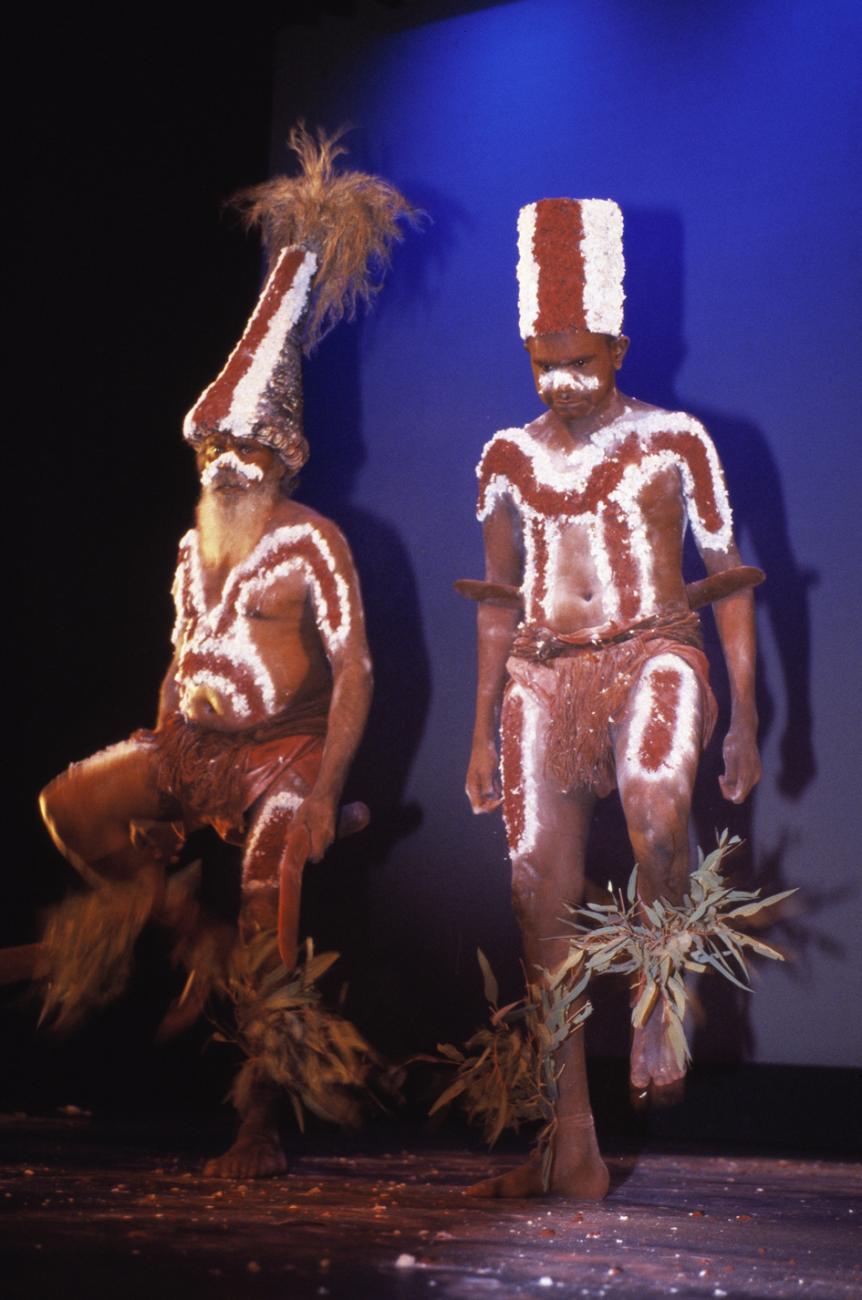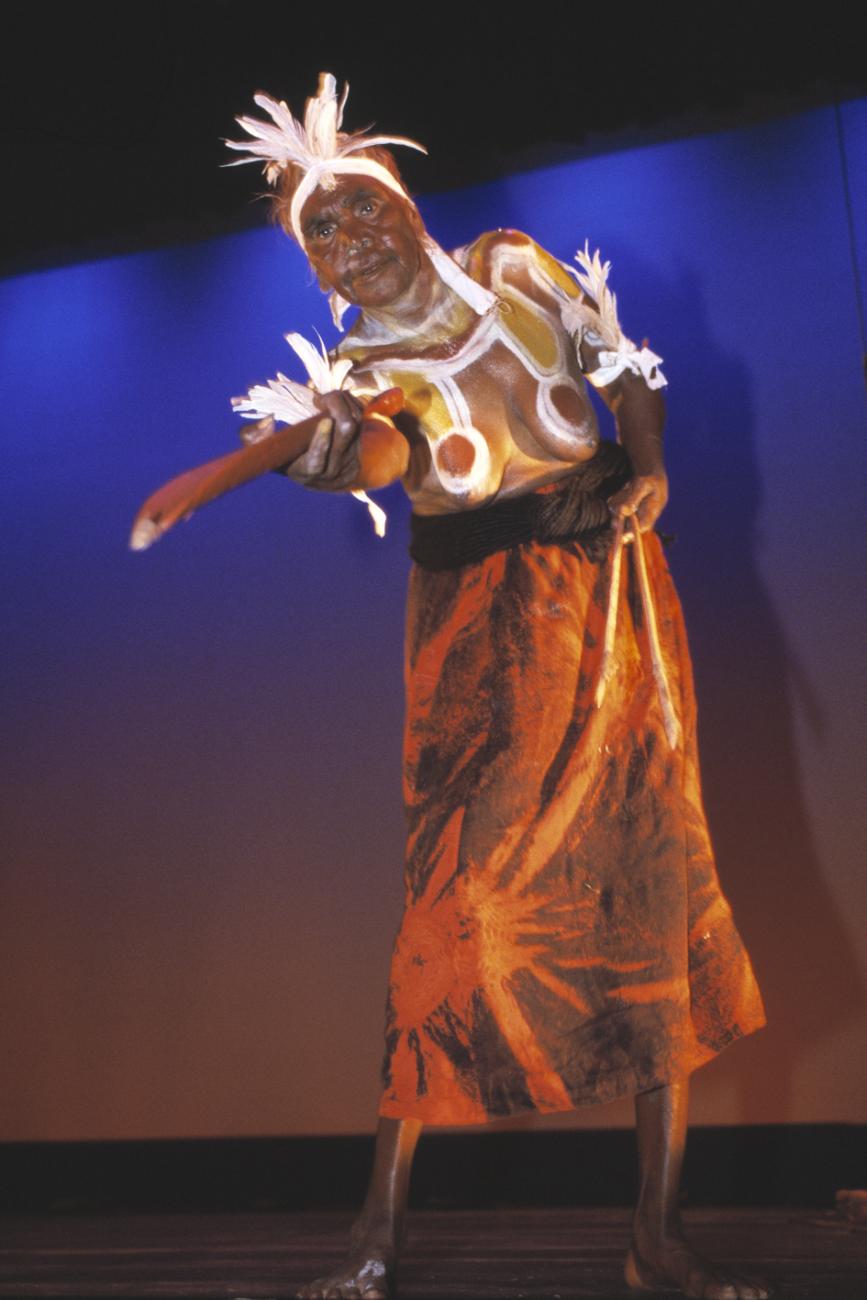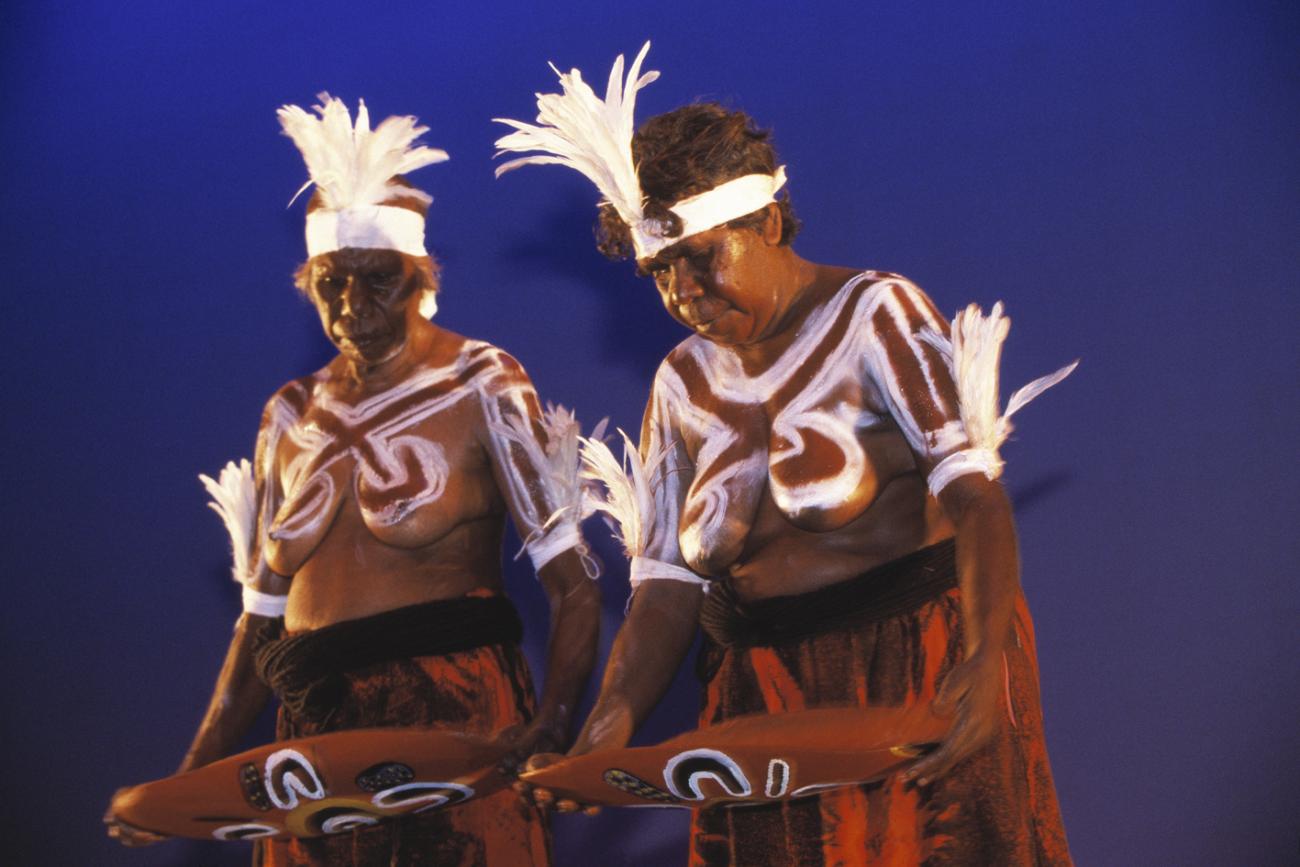Janganpa - Janganpa Dancers co-production
Text
Araluen Centre, Alice Springs
3 Shows - September 6-7, 2003
Alice Springs Festival
Lying down in the desert the low grass seems tall
Janganpa was a co-production between the Janganpa Dancers (manages by VAST) and Tracks dance company. It was a dance performance of spellbinding beauty that howled through this vast ancient land, starring the Janganpa Dancers, traditional elders of the central desert who presented epic stories of love, greed and desire. Janganpa transported the oldest dance of this land into the 21st century. This performance was directed by Tracks dance company and presented by the Araluen Centre.
The Janganpa dancers are a troupe of Warlpiri and Anmatyere singers, dancers, painters and film actors. They have appeared in many films including Kings in Grass Castles, Rabbit Proof Fence and The Tracker. They have also performed their traditional dance locally and overseas, in New Zealand, Germany, Korea and Norway.
The Janganpa Stage Performance at Araluen evolved from a meeting between the dancers and their manager Peter Yates, and Tracks’ Artistic Directors Tim Newth and David McMicken. The two parties came together to watch some videos of Tracks’ performances that had been developed in collaboration with Aboriginal performers from Lajamanu in the Northern Territory’s Tanami Desert.
The Janganpa elders were impressed by the work of Tracks, and asked them to help transport their traditional dance into the contemporary world. They needed to retain the integrity of their dance while making it work in a traditional Western theatre.
Directors Notes
Lying down in the desert the low grass seems tall. Details on the bark of the scraggy scrub stand out as the morning sun races over the horizon. The sound of one man crushing grasses, or women singing as they prepare damper. Always looking for food, looking out for each other. The dull thud of the crowbar hitting wood as women dig for witchetty grubs. Working in the sun, the wind, the desert. Night time and the fires are roaring with light flickering on dancing bodies.
Taking Ceremony from its natural setting into the inside world of the theatre brings with it many challenges. “You cannot change Aboriginal law”. Visual cues that were plentiful have gone, distances out bush are contracted, the sunlight and the fire light no longer provide their magic, the horizon does not exist, nor the huge sky. It is a bit like trying to fit game of football into a lounge-room – the goal posts have shifted dramatically.
Tonight we bring to you the magic of the bush, with steps that have been pressed into the desert sand for thousands of years. When placed together like this they weave an intricate pattern that is complex and hauntingly beautiful. The dancers act as the deed to their land. The stories Janganpa tell are as important now as they were then. They are pointers for survival in a harsh land that has been the demise of many early Westerners.
The stories will: guide you over long distances; highlight the importance of looking after young ones and passing on information; help you find water by following other animals, care for the land, flush out tucker; and tell you what happens if you chase the wrong women. They are also dances of celebration.
These dances come from a time where ‘now’ went for longer, a time without the constant rush to achieve the new, where there was not such a separation between the participants and the observers.
We thank the Janganpa dancers for allowing us to take this journey into the theatre together. We hope you can gain some insight into a worldview that has developed over many thousands of years and is intimately connected to the desert lands for which many of us share a love.
Janganpa is a troupe of Warlpiri and Anmatyere artists
Janganpa is a troupe of Warlpiri and Anmatyere singers, dancers, painters and film actors. They regularly perform short pieces of their traditional dances locally and overseas, in New Zealand, Germany and Korea. JANGANPA was conceived because the elders of the Janganpa dancers wanted to transport their traditional dances into the contemporary world. They needed to retain the integrity of their dance while making it work in a traditional Western theatre. Through their manager Peter Yates they contacted Tracks and asked them to direct the show.
"We thank the Janganpa dancers for allowing us to take this journey into the theatre together. We hope you can gain some insight into a worldview that has developed over many thousands of years and is intimately connected to the desert lands for which many of us share a love."
Creative Personnel
Producer: Peter Yates (VAST)
Directors: Tim Newth and David McMicken (Tracks)
Directors Assistant: Catherine Hassall
Lighting Design & Technical Director: Greg Thompson (Araluen)
Production and Promotion Personnel
Assistant Technical Director: Michelle Small (Araluen)
Production Assistant: Ben Pollit (Araluen)
Marketing Manager: Andrea Lehman (Araluen)
Promotion: Suzanne Fermanis (Tracks)
Bookkeeper: Heather Richards (Tracks)
Deputy Director: David Lloyd (Araluen)
Costume Construction: Pamela Bladon
Catering (rehearsals): Anne Marie May
Poster Image and Design: Mark Marcelis
Performers
Janganpa Dancers:
Women: Noreen Nampijinpa Robertson, Lydia Nangala Sampson, Ida Nangala Granites, Pamela Nangala Williams, Audrey Napanangka Martin, Judy Nampijinpa Granites, Topsy Napaljarri Dixon, Maggie Nakamarra
Men: Johnny Possum Japaljarri, Ted Egan Jangala, Jimmy Jangala Collins, Charlie Jampijinpa Brown, Albie Jampijinpa Morris, Frankie Japanangka, Derek Egan Jampijinpa
Scenario
Act 1
- Women’s dances Lukararra Seed Three women travel over such distances that they cripple their feet and fall over exhausted.
- Watiya Warnu: Mulga Seed. Two women are gathering seeds while travelling south. One woman, who is greedy, tries to steal the seeds from the other.
- Ngalaji/Wapadi: Yam. One ‘lover boy’ watches two women digging for yams. Although they are of the ‘wrong skin’ he chases them anyway and they have to constantly repel him.
- Wardapi: Goanna. The goanna man has been fighting for a woman of the ‘wrong skin’ for him to take as his wife. He checks out his muscles and looks at his cuts from fighting. Looking mighty fine he takes off to the east looking for more people to fight, and then returns west.
- Lukkarrarra: Seed. While their mother is grinding seeds to make bread, two hungry children are crying for food, and trying to eat it before it is ready.
- Luralingi: Lizard. Small lizards are gathered as they are flushed out by burning the grass.
Act 2
- Film. This short film takes a glimpse at the association between fire, song and dance, art, hunting and gathering, and the maintenance and teaching of traditional culture. Through these activities, members of the Janganpa group have travelled across the country, and overseas, sharing their culture and gaining a variety of skills and experience.
- Credits: Camera: Peter Yates Editor: Anna Simpson Music: Lajamanu Teenage Band Sound: Bill Davis.
Act 3
- Men’s Dances Janganpa: Possum Travelling Possum man sets out and gathers up all the young possums and brings them back to his country.
- Yangkarri: Emu. Following the advice spoken by the ancestor, the Emu is trying to get safely to a waterhole to have a drink. When the birds are in the sky it tells him that someone is at the waterhole, maybe wanting to kill him. When the birds are at the waterhole it is safe to drink.
- Janganpa: Two Men Fighting. Two ancestral possum men approach a sacred waterhole from different directions. They fight with each other before making peace.
- Warlu: Bushfire. Fire is travelling south to Warlukurlangu. It went into a cave and it is still going now under the ground. It is a very dangerous story.
- Finale
Thank You
Tim Rollason, Sonia Maclean, Jenny Croker (CAT), Artback NT Arts Touring
‘Araluen’ is the aboriginal word for ‘place of water-lilies’, and was adopted as the name of Eddie Connellan’s property on Larapinta Drive, from where he operated the Centre’s first airline. In 1982 work began on the cultural centre and theatre complex, and it opened in 1983. The Araluen Centre provides a cultural complex for the pursuit of live theatre, the arts and craft. It is administered by the Araluen Trust and has exhibition galleries, an art gallery, a sculpture garden and a 500 seat theatre. The Araluen Centre is part of the Alice Springs Cultural Precinct, which is comprised of 8 attractions. These are:- The Araluen Centre & Galleries, The Namatjira Gallery, Museum of Central Australia, Strehlow Research Centre, Central Australian Aviation Museum, Territory Craft, Alice Springs Memorial Cemetery and the Grand Circle Yeperenye Sculpture.
VAST Film Services. The Producer of Janganpa and manager of the Janganpa dancers is Peter Yates. Peter manages a company VAST that is a casting and talent management agency. VAST also provides ongoing contract work, management and mentorship for the Janganpa group. Information on VAST can be found on www.vast.com.au
Tracks 2003
Artistic Directors: David McMicken and Tim Newth
General Manager: Suzanne Fermanis
Dance Animateur: Julia Quinn
Book-keeper: Heather Richards
Publicist: Sue Camilleri
Office Administrators: Heather Richards (Jan - Feb), Janice McEwan (March - April), Rukshana Ramachandran (June - August), Jolene Mooney (September -December)
Committee Members: Jackie Wurm (Chair), David Taylor (Vice-Chair), Glenn Bernardin (Treasurer), Kyleigh Hindson (Secretary/Public Officer), Ken Conway, Donna Quong, Jill MacAndrew, Kay Brown (Ordinary Committee Members), David McMicken and Tim Newth (Ex-Officio Members)
Photos
Videos
Explore Further
Media Responses
"Alice’s desert dancers blur dividing lines. Dawn breaks on the back-projection of the desert; light rises on the Araluen Centre’s wooden stage. Clap sticks clash together. A group of Warlpiri women, in full body paint and feathered head dresses, begin their ritual movements. Grave, gripping, traditional, the debut Western performance by the Central Deserts’s Janganpa Dancers earlier this week was the signature event of this year’s Alice Springs Festival…Pride of place though belongs to the Janganpa Dancers, a group of traditional elders, some in their 80s, who have co-operated with Darwin’s Tracks dance company to bring their traditional tales of "love, greed and desire" before the eyes of the wider world." Nicholas Rothwell, The Australian

